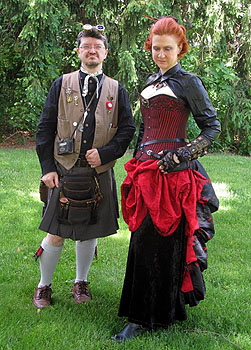
Practical Scotsman
This article discusses the male costume on the left. The red ensemble on right has his own write-up.
The model in question here is my husband, Jerry. He doesn't craft fabric at all. He does do some thrift shopping, but I don't always known which garments are from Goodwill and which aren't. As such, a good deal of this article will be about getting the look, even if it doesn't describe the specific piece here.
Purposes
- Practical look of a hands-on engineer
- Able to be worn throughout a day
- Provides a way of easily carrying items such as car keys and cell phone
Goggles
Steampunk goggles range anywhere from $20 on up. Variations include materials used, paint jobs, alternations and additions. If you're in a crafting mood, you can buy goggles such as welding goggles at your local hardware store and paint them yourself.
Shirt
The shirt was purchased through a steampunk vendor, but any regular shirt will do. This one is "steampunk" because it has little gears for buttons. If you don't like the buttons on a shirt, you can always buy buttons and replace them. I've repeatedly replaced boring, plastic buttons with a variety of flashy, metallic ones, which automatically gives the garment a different visual feel.
Vest
Vests are hard to find in both Goodwill and department stores. They just aren't in fashion now, while they were practically required for men in the 19th century. If I Google "vest" under the shopping tab, I get an awful lot of $100+ items. However, there are also some under $20 options, so they are out there.
Utilikilt
Jerry has a more traditional walking kilt, but here he sports a Utilikilt he bought on clearance. Utilikilts are made of durable material and sport several pockets. They lend a less formal and more practical look to an outfit.
Belt
Traditional kilts have a pouch known as a sporran hanging in front of the kilt. Here, a regular tool belt has been used. Not only does it fit the theme of practical engineer, but it also hides his cellphone, car keys and other anachronistic items.
Socks and Shoes
The socks and sock garters are traditional accessories for kilts.
The shoes are his everyday shoes. They aren't anywhere close to period correct, but they work just fine.